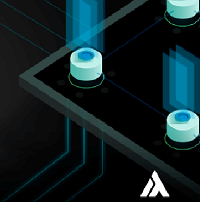 To begin with - we’ll determine what, in principle, means a term that sounds like sharding.
To begin with - we’ll determine what, in principle, means a term that sounds like sharding.
The dictionary says that “sharding” is segmentation, “shard” is a splinter.
And here, it would seem, blockchain and cryptocurrencies in general? Encryption algorithms in general and terahash in particular? What relation, some fragments and segmentation can have to crypto networks?
But in fact - everything is simple, if
have a more or less intelligible understanding of the mechanisms for storing information in databases, or understand the basics of scaling web applications and the problems caused by a large number of requests and requests from users of services to a website, application, and database.
When a resource, let it be a server, ceases to cope with the load of data sampling / recording, admins are forced to look for a way to increase productivity.
First they stick more memory, processors, fatter and more in number, fence gardens from disk drives combined into a common, ultra-fast storage, expand their communication channels, gradually turning their server into a personal data center ... In general, they solve a lot of technical problems, while delays information exchange with users will not be eliminated.
This strategy justifies itself when it comes to a small enterprise with several branches in different cities, and the number of employees who need access to the database (website, accounting, here the user interface is not important, we are talking about a fundamental problem) is relatively small and capacity building servers fits into the policy of equipment operation and company capabilities.
However, what if, for example, you are the owner of something like Facebook or aliexpress, and the cost of storing, fetching, transmitting information is already calculated in ten-digit digits in the dollar equivalent?
Two proven and, therefore, reliable, solutions come to the rescue:
First: clone the server. That is, we stupidly put two identical sets of iron and redistribute the load, organizing the redirection of requests to any of them that can respond right away. This is replication.
Second: we distribute information into certain segments, parts, load these parts into different servers, connect it (information) and their (server) with logical routes and redirect requests directly to where the information is stored, receiving a fantastic gain in stability and time. This is sharding.
Well, finally, we almost got to our rams.
 Cryptocurrency without a blockchain is a virtual exotic toy that is unable to exist in this world, simply because there is no way to check at least some certainty of transactions, wallets, events and everything that is important for the existing reality based on facts unshakably recorded in the past.
Cryptocurrency without a blockchain is a virtual exotic toy that is unable to exist in this world, simply because there is no way to check at least some certainty of transactions, wallets, events and everything that is important for the existing reality based on facts unshakably recorded in the past.
And the blockchain is still a database, although this comparison is somewhat inaccurate, and the database is constantly growing, and even in a huge number of replications (full copies), each of which is processed by a separate node (node / wallet) of the crypto network.
And this leads to various problems that the coin / blockchain developers are forced to solve, who are interested in the fact that their technology will find widespread use.
And, without delving into the technical subtleties of the functioning of the large family of altos, which have gained confidence in the digital economy of the crypto world, we can say with confidence that the phrase “insufficient bandwidth” most accurately describes the main problem of all crypto networks.
Each coin has a limit on the number of transactions that its network can process for a specific period of time. And this problem is so serious that the usual blockchain construction concepts, the encryption algorithms used, do not give a sufficiently good result without violating one of the main principles, as the basic one that affects the value of cryptocurrencies - decentralization, or in other words - the lack of the possibility for targeted intervention. With existing technology, the choice was simple: either an absolutely decentralized crypto network with several transactions per hour or centralized, with several transactions per second.
When it comes to crypto networks used as a platform for electronic money - no matter how it is. Even the slowest cryptocurrency moves faster than a bank transfer. But slower than an electronic payment VISA or MasterCard!
The dignity of anonymity (very controversial in light of the ability to scan blockchains, which usually have an open access format and great tools for parsing them, coupled with fixing IP addresses and geolocation data of a cryptocurrency user) overcomes many of the shortcomings of banking systems.
But if we are talking about crypto networks acting as an environment for executing machine code, as a technology that is the result of natural growth in the field of distributed computing, then low bandwidth becomes a stumbling block in the existence of decentralized software, the prospects for building artificial intelligence, which has already become a reality of the Internet things, and other similar innovations that should lead the human race, according to a large number of experts, out of the swamp existing problems.
 Without focusing on the existing technological solutions used in the alt, recognized by the crypto world, the personalities who made a huge contribution to the development of these solutions, I will talk about the breakthrough concepts of the formation of the crypto network and blockchain, cost and some aspects of socialization offered by the creator of the TERA project.
Without focusing on the existing technological solutions used in the alt, recognized by the crypto world, the personalities who made a huge contribution to the development of these solutions, I will talk about the breakthrough concepts of the formation of the crypto network and blockchain, cost and some aspects of socialization offered by the creator of the TERA project.
To begin with, the concept that the blockchain is just a chain from a sequence of blocks was dropped.
That is, in its saved form, replicated on accessible nodes, the blockchain stores chains consisting of blocks filled with data about events and facts about what is happening in the crypto network, which make each block reliable, verified thousands of times by miners and impossible to change. Everything is as it should be, according to the idea of Mr. Nakamoto.
However, the process of forming the blockchain, in TERA, does not provide for a deadly battle for the quality and quantity of data in each new block, which chokes the bandwidth around the neck.
What for? In fact, this is not required!
Well, let a working crypto network generate blocks with a wild (by the usual standards of a decentralized crypto world) speed: one block in one second. And this is not done by five to ten-hundred “trusted” powerful servers, as existing leaders in the blockchain industry are trying to implement, but all the crypto network nodes, together, but independently from each other, generate one block in one second. And only then, in the next few seconds, the already generated blocks pass verification and, the most consistent with the rules of consensus - is fixed as a chain link.
A block in the blockchain remaining in perpetual storage.
All the others, generated, but not included in the saved blockchain, which would previously be considered orphans and applicants for spontaneous forks, simply remain behind the scenes, leaving for scrap like scaffolding after the construction is completed.
Thus, we have a system that is similar to an extensive communication system that connects points of departure and reception of data delivered simultaneously and immediately to everyone. Well, the recipient of the information / payment / executable code, can only accept what is required, according to the details specified by the sender, regardless of their location.
So here it is, the first concept.
Of course, there is a second one, arising from the technological solution for the TERA blockchain and crypto network.
I don’t know how to call it right, but I call it the monetary policy of the blockchain.
Usually, after all, how is it arranged?
There is cryptocurrency, it has a certain amount of coins laid down as the final one in the generation mechanism, and there is a simple way to complicate the extraction of coins and thus stimulate a price increase. Algorithm, halfings, growth in mining capacities, throughput, capitalization of mined coins and assets related to this - this is an incomplete list of components that, in turn, stimulate social activity that forms the need for this coin, and, accordingly, demand and price.
In TERA, some of the elements listed above are also present, as it were, but nevertheless, the differences are drawn so that they can be safely classified as innovations that no one has yet proposed analogues, although you can find some similarities can. But there are clouds that look like people! So that…
Honestly, I’m already bothered to print this text, and you should read it, so I’ll send it to the white paper, read books, discussion forums for details of monetary policy, and in a nutshell I’ll say: scooping out all the coins from the TERA blockchain is unrealistic, due to mechanisms that return some then the number of coins in the initial heap, which is generated immediately, at the time of the launch of the crypto network and from where they (coins) then come as a reward for the mined block. One of the results of this chip was the opportunity to make sending transfers between participants free of charge, without losing reward to miners.
A 51% attack for the TERA network also does not have any significant danger, due to both the specifics of the formation of the main chain and the conditions for the distribution of the reward for the mined block.
Of course, the crypto network of the TERA project is the basis for the work of program codes written, by the way, in Java, which, in theory, is a plus, since this language is very common among a wide variety of layers of developers and users.
These codes allow you to create a variety of contracts, publish them on the network, and recall when the meaning of their execution is lost. They can’t get away from the blockchain anywhere, but their activity can be controlled! And this is a guarantee that there will not be a situation in which a sacrificial hard fork is needed, canceling some fatal event due to fraudulent actions of some kaker or a mistake of a particularly stubborn developer, violating the community’s financial plans and causing its split by an unnatural demand to change the past into blockchain.
And of course, you can create your own tokens and these will not be scary ERC20 standard tokens, which should be handled like explosive mercury, but quite adequate, convenient and safe assets that fully correspond to their purpose and intentions of the person who creates them.
And - a cherry on the cake: the concept of sharding is currently being discussed.
 Frankly, the author calls him sharding, but in fact, this is not the sharding mentioned in ethereum or coins that appeared after his (ethereum / ethereum) success. There they rushing at an abstruse bisovschina, justifying the possibility of building a system that would find some identifiers in the headings of the blocks of the main blockchain, associate shards by these identifiers and this would allow working with shards without bothering with the blockchain itself.
Frankly, the author calls him sharding, but in fact, this is not the sharding mentioned in ethereum or coins that appeared after his (ethereum / ethereum) success. There they rushing at an abstruse bisovschina, justifying the possibility of building a system that would find some identifiers in the headings of the blocks of the main blockchain, associate shards by these identifiers and this would allow working with shards without bothering with the blockchain itself.
But here is the mechanism how to identify the nodes that confirm the blocks, link their generation, the identification between shards and the main blockchain - so far it has not been possible to come up with. Their whole concept starts to look like the concept of a central bank, with servers generating blocks of shards and nodes, verifying these shards and delivering them at the right time to the right place. And the decentralization of kaput turns out, and even the POW mechanism changes to the POS mechanism, the concept of which is based on a hold of significant amounts to ensure the integrity of the node that has the right to confirm the block, which immediately gives this very validation / verification / confirmation to the richest participants of the crypto world, without a chance of mass, and that, you know, is not at any goal !!!
Given that no one has yet done anything worthwhile, but didn’t even propose, we can safely put an end to this concept, because in the crypto world time is fleeting and the year is a whole era in his life, and to talk about something that will happen in two, three years is fantasies, dreams, or even drug addictions.
The concept of sharding in TERA, according to the creator, is simple and elegant, like all ingenious.
If you want sharding - put your node, put it into fork mode, come up with a name for your coin and - voila! Your personal network, your personal cryptocurrency - ready! You can work with one node, you can instruct them (nodes) as much as required by your plan. You can lure everyone into your network who is interested in the prospects of the idea behind your shard and its economic, ideological and some other ideas and concepts.
To your health!
Your shard and the TERA blockchain work in unison, reinforcing each other, protecting against the toxicity of the outside world and forming the value of your coin right from the moment it appeared - the value of the TERA project coin, or rather, its capitalization. And the development of your coin will push up the price of the TERA coin. Rocket! With a forward-flow fusion reactor! And no exchangers, tunnels, payment channels, swaps and other crutches are needed so that your new and unique coin has wide circulation! Your shard has generated a coin - you can get the equivalent in TERA for it without any effort. Most likely, it will be displayed in the equivalent of balances. Want to exchange your coin for another alt? Yes, no questions asked, TERA has more than 20 exchanges and exchangers! Change TERA to anything within the equivalent available on your wallet balance ...
Moreover, as a rule, a coin is not created just for “what would be”, but for some kind of economic miracle, which needed a similar digital solution based on the economy of the digital world community, and accordingly, some kind of cost is planned on it, participants are motivated to contribute to the growth of its price and successfully cope with it.
If earlier the only way to sell the idea and organize the economic stimulation of the mover in your project was tokens, now you can don’t take a steam bath, but immediately get a coin in your hands and a complete set of tools for automation, mechanization, organization, digitalization and other amenities that digital technologies are attractive .
Mnd ...
We need to hide our author, prepare to defend him, because the competitors will become embittered, because many will go “derailed” if they do not understand that this concept puts an end to the whole family of technologies that are now trying hard to implement projects that have gathered oohljards at their bubble collections in the form of ICOs and ITO.
PS And for those who have already tasted the proposed concepts, and the topic is tight enough - you need to put all your energy into its development, documentation, promotion, experiments, training, because this concept will usher in a new round in the development of the crypto world and digital economy of a decentralized society.